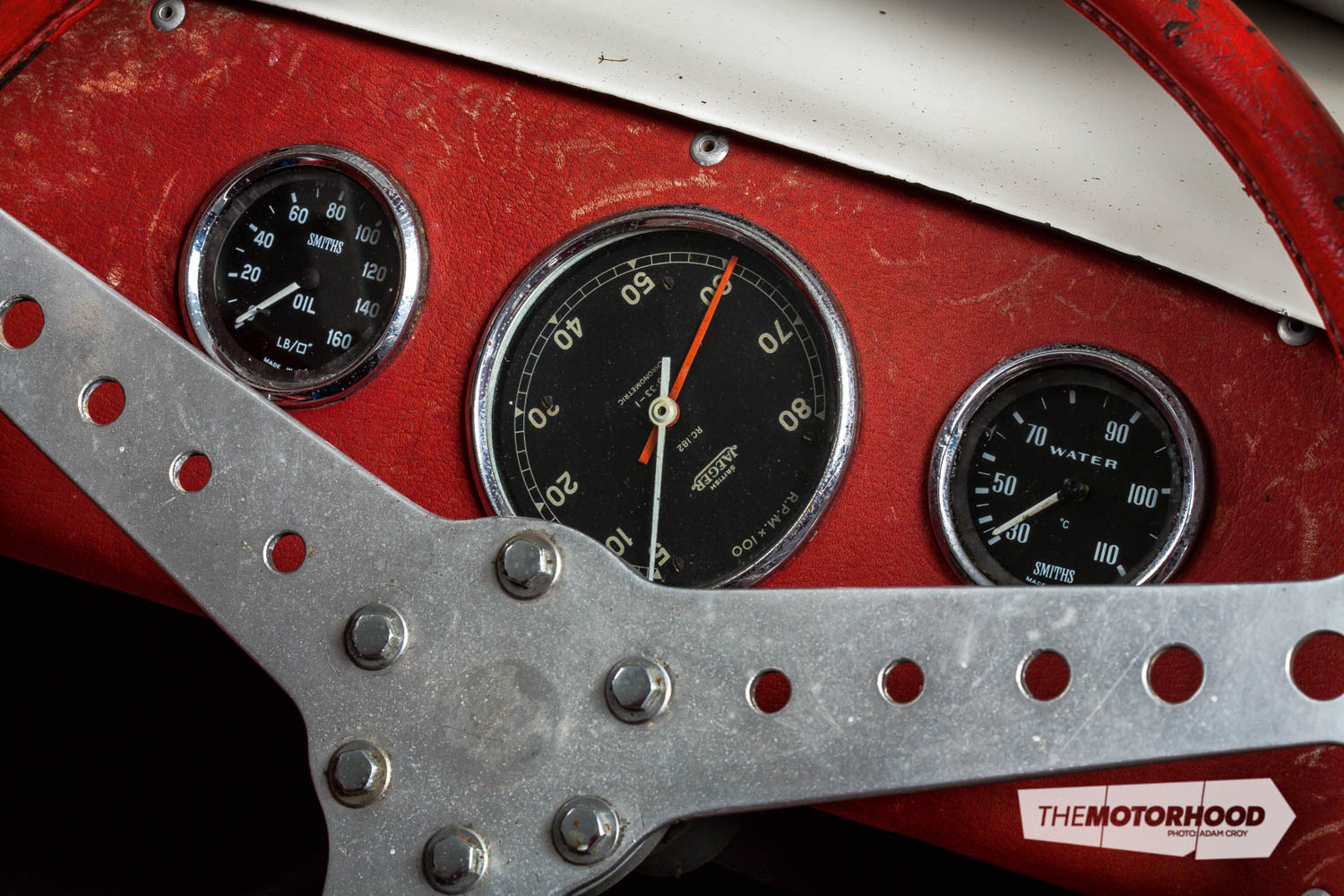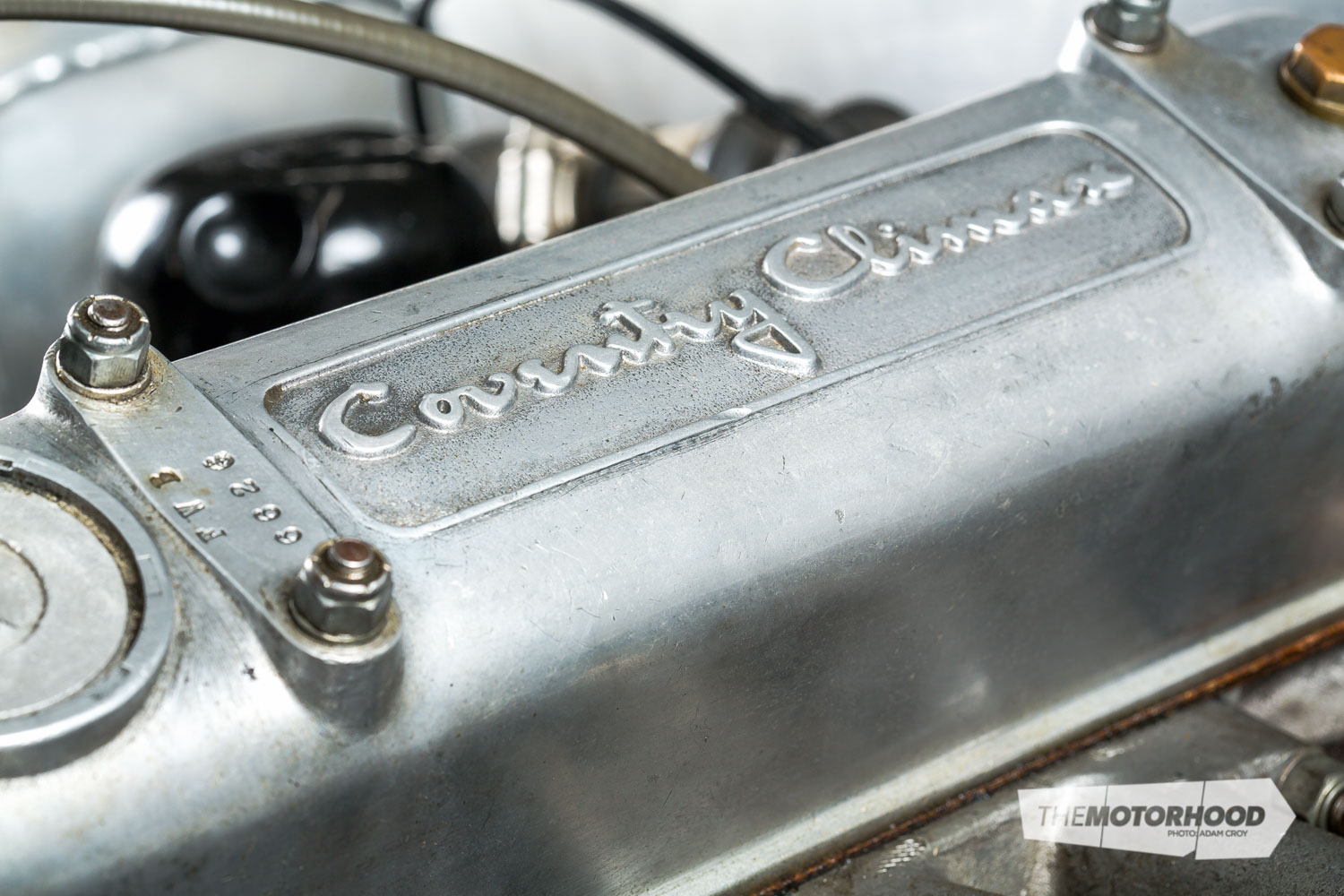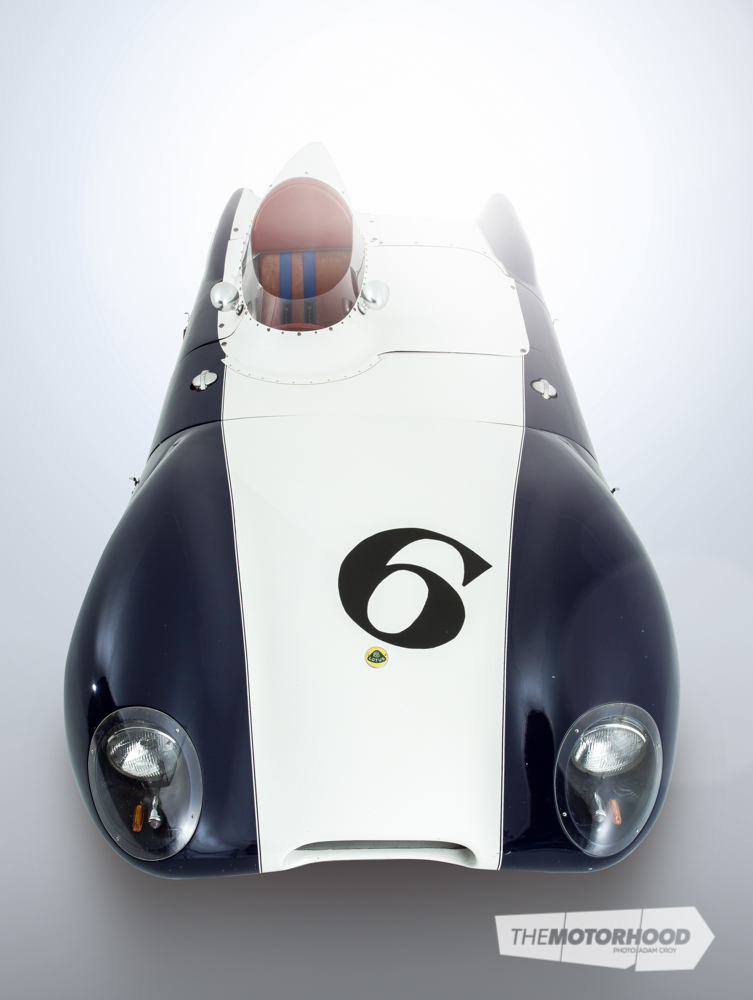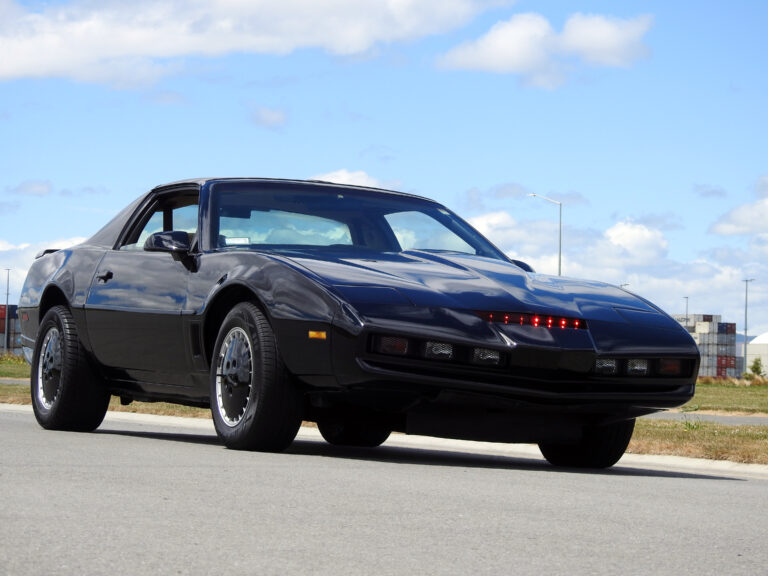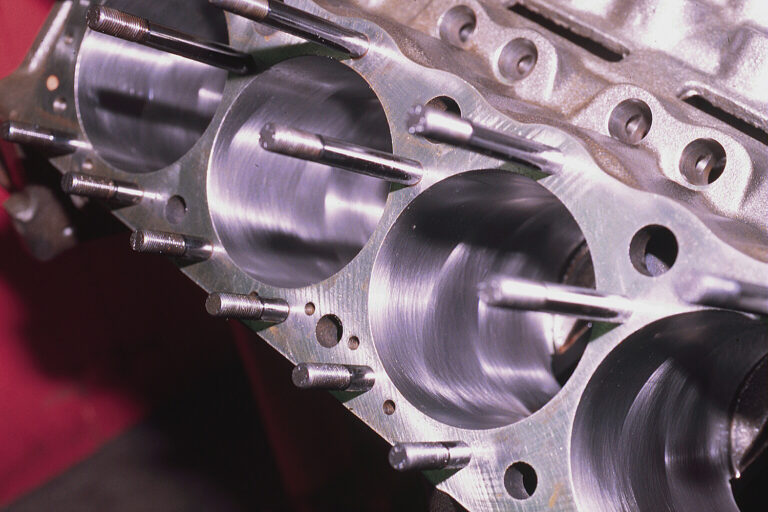data-animation-override>
“Howden Ganley’s first foray into motor sport was at the wheel of his mother’s Morris Minor — but, ready for a proper racing car, he acquired this Lotus Eleven in 1960”

It is believed that around seven Lotus Elevens came to New Zealand, available in either Club Sport or Le Mans form, and the first of them was this Le Mans version. Fitted with a 1099cc Coventry Climax FWB engine (E6837), the car’s first appearance was in the hands of noted speedway racer, Auckland-based Roly Crowther. Crowther owned Auckland Motor Painters, and he applied his expertise on the car’s eye-catching blue and white paint scheme. Alas, the Lotus couldn’t match its striking appearance with good race results, and the car was sold to Christchurch-based garagiste Des Wild in 1957. Wild quickly proved the Lotus’ worth by setting a new Class G (750–1100cc) speed record, completing the flying start kilometre in 18.115 seconds with a terminal speed of 123.5mph (198.75kph) on October 5, 1957. However, on the lookout for more power, Wild soon replaced the Lotus with a considerably faster Jaguar C-Type and, in 1958, the Eleven was on the move again — this time to George Palmer, who bought the car for his young son, Jimmy, to race. Jimmy’s best results in the Lotus were a class win in the 1959 Ken Wharton Memorial Trophy race, and a third placing at Waimate. Midway through 1960, the Palmers on-sold the Lotus to Johnny Windleburn, who raced the car very successfully at Levin and Wigram.
Once again the Lotus was put onto the market, and this time around a young Hamilton-based youngster, Howden Ganley, entered the history of this particular Lotus Eleven.
A proper racing car
Having made his competition debut in his mother’s Morris Minor, Howden got a real taste for speed after being taken around Levin by Len Gilbert in his Cooper Bristol, the ex-Horace Gould, ex-George Palmer car that had been widened to qualify as a sports car. Howden wrote a story for The Waikato Times about that ride, and the die was cast — it was time for a proper racing car!

Howden takes up the story. “The Lotus Eleven that had been raced by Jim Palmer was now owned by Johnny Windleburn, and he had it for sale at £1300. I had to have it. It had the full works, and I knew the car well from when Jim had it because he also lived in Hamilton, and we all knew each other. Somehow, I managed to scratch up the money by getting my grandmother to give me my 21st birthday money and all my birthday presents up to that. I sold everything I owned. I sold my bike, which was serious stuff then. I fitted my brothers up with all sorts of old rubbish and I raised £650, which was half way there. The bloke who was going to come in with the other half reneged, so I managed to get my mother to loan me the other £650 and we bought the car. It was beautiful. It had a Climax 1100cc engine and was simply the business. The problem was that now I was skint. I didn’t have a trailer, I didn’t have a tow car and I had no money left.”
A genuine Le Mans 85 model, as acquired by Howden, the Eleven was fitted with all the Le Mans–spec items such as twin fuel tanks and dual tachos, as well as a metal tonneau cover and wraparound screen. Indeed, many years later, on a visit to the Lotus factory in the UK, Howden’s brother, Denis, was told that there was a chance this Eleven could have been one of the works cars which had raced at Le Mans — although this couldn’t be verified.
Howden’s first race in the Lotus was at Ardmore in December, 1960. However, his first big race came a few weeks later at the 1961 NZ Grand Prix weekend at Ardmore. By now the Lotus had been repainted in green, and the Coventry Climax engine was rebuilt, as was the differential, in time for the race weekend.

Howden — “I won my class in the sports car race (and £15) and I went in for the Ultimate Ecko race for New Zealand drivers that paid the phenomenal amount of £150 to win — and I won it! Suddenly, I could afford to go racing for the rest of the season. I talked Denis [Howden’s brother] into buying an old 1936 Chevy, and I borrowed the trailer that my father used to haul his Ford Ten special sports car. We took the back seats out of the Chev, loaded the spares in and away we went, with Denis as my mechanic for Levin and Wigram.”
At Levin, he spun out of the race with only half a lap to go and in second place, but had better luck at Wigram where he scored class seconds in two races.
With Denis having returned to work following the Wigram races, Alistair Caldwell — who would later make his name as McLaren’s chief F1 mechanic — joined the small Ganley racing équipe.
The next meeting on the agenda was the Dunedin round-the-houses race where a faulty fuel line stopped him from finishing the sports car race and, in the main race, he was sidelined after hitting a kerb. Howden fared no better at Teretonga, and a dropped valve meant Howden was a non-starter at Waimate. In his first full season in the Lotus, one of Howden’s few real successes came when he recorded a class win at the Mt Tarawera Hillclimb in Rotorua.
The Motordrome Racing Team

For the 1962 racing season, Howden became part of the Motordrome Racing Team. Formed from a group of racing drivers who gathered together regularly at Ivan Segedin’s garage in Hamilton, as well as Howden and his Lotus Eleven, the team included Dennis Marwood (Humber 80), Bryan Innes (ex-Segedin Zephyr MkII) and Ross Greenville (Lotus FJ). All the team cars were painted dark green with silver stripes and, although the team would only exist for a single season, overall it was deemed to be successful — especially for Marwood and Innes.
Sadly, 1962 didn’t turn out as well for Howden and the Lotus, with a best placing of fourth in the sports car race at Wigram.
He did finish fifth in the Ken Wharton Memorial Trophy race at Ardmore, but no prize money was paid out because there had not been sufficient starters.

By this time Howden had set his sights on travelling to the UK to further his racing career and, consequently, he had a buyer for the Lotus waiting to take delivery following Howden’s final race in the car. That final race took place at Dunedin in the pouring rain over the notorious street circuit. A young Chris Amon crashed from the race in his Maserati 250F, taking out Bill Thomasen’s Cooper Climax in the process. However, worse was to come when Johnny Mansel — who only joined the race at half distance — skidded off the diesel-slicked bus-route road in his Cooper Maserati, being thrown clear as his car snapped in half after hitting a telegraph pole. Mansel succumbed to his injuries 10 days later. In practice for the race, Howden also lost control in the same area, wrapping his fragile Lotus around a telegraph pole.
In July 2012, Howden remembered his crash at the right-hander on the grimly named Cemetery Rise, located at the Princes Street end of South Road. “I still think it could be taken flat out!”
Indeed, that’s what he was doing when he hit what he reckons was a mid-corner bump that sent the sensitive Lotus diving off the road at a speed approaching 200kph.
This happened, of course, in the days before major safety measures such as Armco barriers, and street-racing circuits were surrounded by unprotected kerbs — not to mention telegraph and power poles. Happily, Howden emerged from the Lotus uninjured, the car having slid along the straight rather than abruptly speared off the circuit.
The crash left the Lotus badly damaged, and his plans to make a trip to the UK were now in trouble.
“The Lotus was brought home to Hamilton, and my father and Pete Kerr rebuilt it, but my buyer, I suppose understandably, had second thoughts. The market had shrunk and we got enough out of the car to pay for the repairs, repay the £650 loan from my mother — and by the time I got to England I had £25 in my pocket.”
Later years

The Lotus did finally find its way into the hands of a new owner in December 1963, when acquired by Graeme McLeod of Auckland. Subsequent owners would include Mark Petch, Bill Hughes and Gordon Clarke. Significantly, Peter Bruin also owned the Lotus, and he was responsible for totally rebuilding the car before selling it to Howden’s brother, Denis, who by that time had made a name for himself as an internationally renowned boat designer. Bruin also used the Lotus as the basis for his own Lotus Eleven replica. Subsequently, the Eleven’s original body was replaced by a Bruin-built fibreglass replica body.
Later, Denis sold the car to Philip Stratford who, in turn, parted with it to Gray Mathias. However, the Lotus returned to the Ganley family when Denis acquired the car yet again. He restored it and offered it to his brother, but Howden wasn’t interested at that time, so the Lotus was sold. However, many years later it once again came up for sale, and Denis informed Howden that the Lotus was back on the market.

This time around Howden took the chance to re-acquire the Eleven, and on his return to New Zealand to celebrate his 50th birthday, Denis arranged for Howden and his wife to take over Pukekohe for a private day of track testing in the Lotus — the first time Howden had sat at the wheel of the Eleven since 1962. Today, he states that he is “delighted’ to once again own this iconic sports racer.
Sadly, Denis Ganley — along with this wife, Philomena — both perished in a car accident just outside Murchison in the South Island during May 1997.
Howden Ganley’s Lotus Eleven race history: compiled by Jim Barclay
1960
December 10: Club meeting, Ardmore, Auckland
1961
January 7: NZIGP Meeting, Ardmore, Auckland
- Race 5: Ardmore Sports Car Trophy, Competition No: 109/11 of 12 laps, eighth overall, second under 1500cc class
- Race 8: Ultimate Ecko Handicap, first place
- Race 11: Sports Car Handicap
January 16: Vic Hudson Memorial Meeting, Levin
- Race 3: Sports Car Scratch Race, No. 28
- Race 7: Sports Car Handicap (Reserve), NK if Howden started this race
- Race 9: Vic Hudson Trophy — Formula Libre
- Race 12: Sports Car Handicap
- Race 16: Racing and Sports Cars Handicap, second place
January 21: Lady Wigram Trophy Meeting
- Motor Racing Club Championship, No. 42, second place
- Sports Car Race, second place
January 28: Dunedin Road Race
- No. 17. Retired on lap nine of 36 lap, oil pressure. Classified as 12th
February 4: Teretonga International, Invercargill
- No. 42, fourth place
April 15: Autumn Meeting, Levin, No. 41
- Race 5: Sports Car Scratch Race
- Race 7: Sports Car Scratch Race, second place
- Race 9: Sports Car Handicap Race, first place
- Race 12: Sports Car Handicap Race
- Race 16: Racing and Sports Car Handicap Race, second place
April 29: Hill Climb, Lake Tarawera, No. 42
June 3: Hill Climb, Lake Tarawera, No. 42
- Up to 1500cc Sports Cars, 1st place
- Unlimited Sports Cars, first place
November 25: Fred Zambucka Memorial, Levin, No. 42
- Race 8: Formula Libre Sports and Racing Scratch Heat
- Race 12: Sports Car Handicap
- Race 16: Sports and Racing Car Handicap
- Race 18: Sports Car Scratch (race abandoned due to heavy rain)
1962
- January 6: NZIGP Meeting, Ardmore, No. 67
- Race 4: Ardmore Sports Car Trophy, fifth place
- Race 7: Ultimate Ecko Handicap
- Race 10: Sports Car Handicap (no race due to heavy rain)
January 13: Vic Hudson Memorial, Levin, No. 39
- Race 6: Sports Car Scratch — Heat
- Race 12: Sports Car Scratch — Final
- Race 14: Sports Car Handicap
- Race 18: Sports Car Handicap (race abandoned due to heavy rain)
January 21: Lady Wigram Trophy Meeting, No. 42
- Bardahl Sports Car Race, fourth place, 16 of 20 laps; second in under 1500cc class
January 27: Teretonga International meeting
- No record of entry
February 3: Dunedin Road Race, No. 71
- DNS — crashed in practice. Howden’s last race in NZ [Note: Howden’s placings not known for all races]

